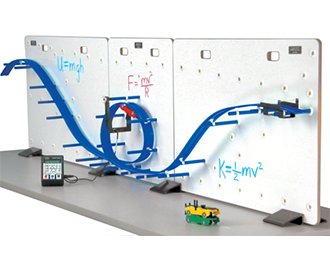Description
In this experiment, the Law of Conservation of Energy is verified by measuring the potential and kinetic energies of a car traveling over hills and loops on a curved track.
A car is started from rest on a variety of tracks (hills, valleys, loops, straight track). The speed of the car is measured at various points along the track using a photogate connected to a Smart Timer. The potential energy is calculated from the measured height and the kinetic energy is calculated from the speed. The total energy is calculated for two points on the track and compared.
The height from which the car must be released from rest to just make it over the loop can be predicted from conservation of energy and the centripetal acceleration. Then the prediction can be tested on the roller coaster. If the car is released from the top of the hill so it easily makes it over the top of the loop, the speed of the car can be measured at the top of the loop and the centripetal acceleration as well as the apparent weight (normal force) on the car can be calculated.
PASCO Advantage: The Roller Coaster can be configured in many ways. The whiteboard background is convenient for writing calculations or making marks for measuring heights. The PASCO Roller Coaster differs from conventional roller coaster toys in three ways:
- Speed and height of the Roller Coaster car can be easily measured.
- Loss of energy due to friction is generally only about 5%.
- Cars will withstand repeated drops to the floor.
Concepts
- Conservation of energy
- Centripetal acceleration
- Apparent weight
Experiments
What’s Included
- 1x Roller Coaster Complete System (ME-9812)
- 2x Photogate Head (ME-9498A)
- 1x Smart Timer (ME-8930)
- 1x Conservation of Energy Experiment Manual



